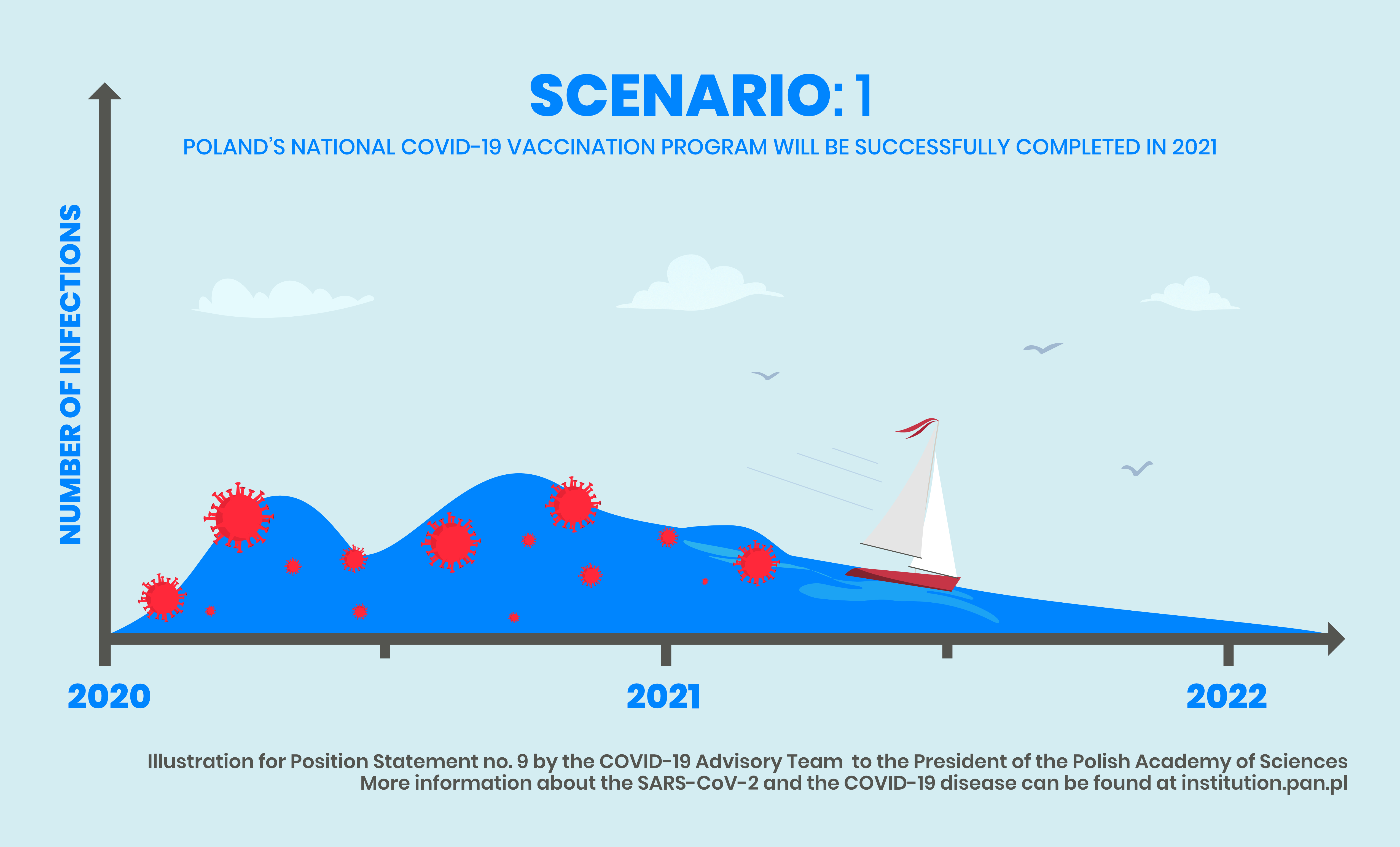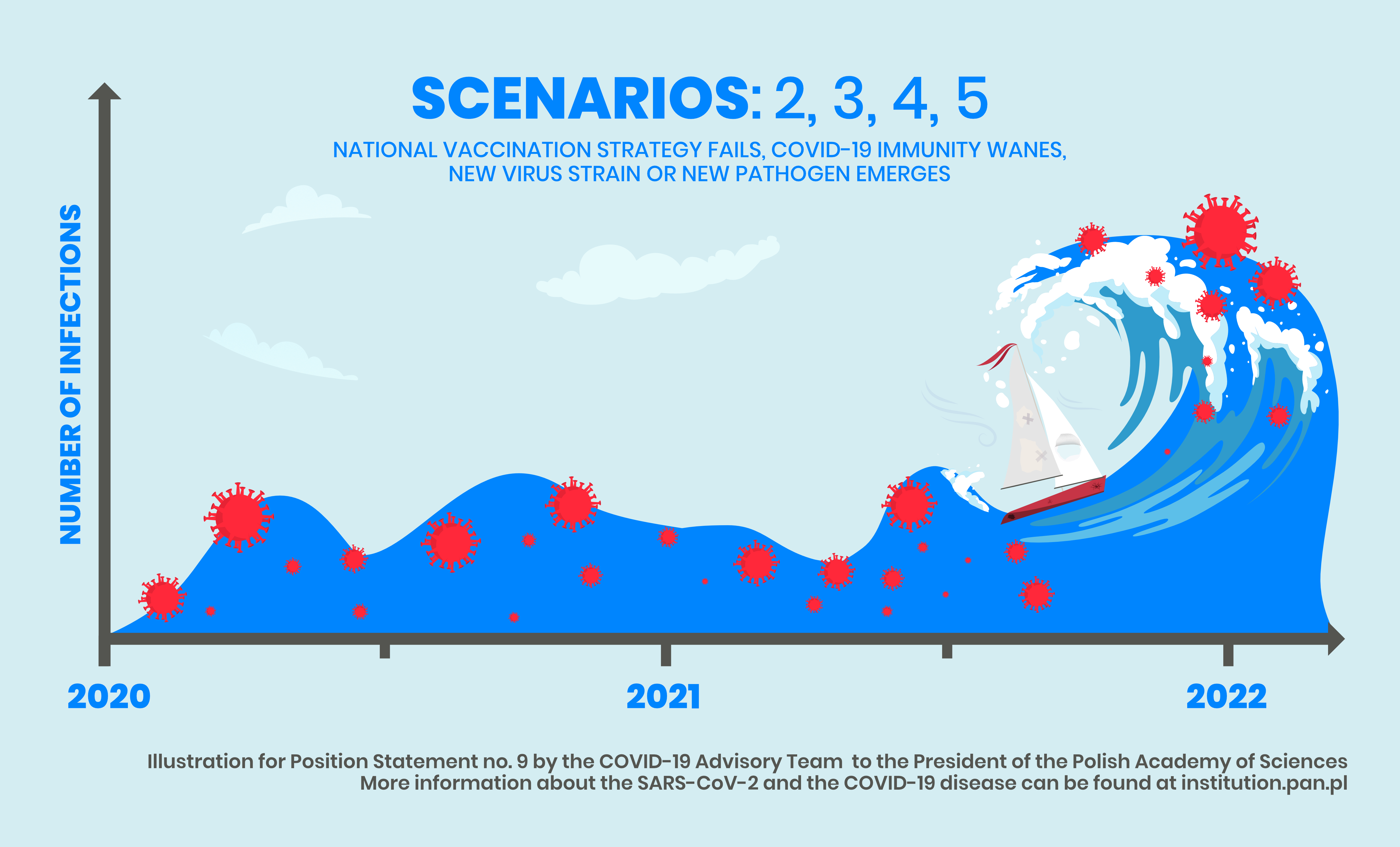Comments on Position Statement no. 9 “Scenarios for 2021”
Since the publication of our “Scenarios for 2021” we have received numerous questions about which of these scenarios is the most likely. However, it is not possible to provide a clear-cut answer. One of the reasons is that the probability of each of these scenarios becoming a reality depends not only on actions over which we have some influence (i.e. the efficiency of the vaccination system and people’s behavior), but also on factors over which we have little influence.

We have the greatest influence over whether Scenario 1 (successful completion of the National Immunization Program in 2021) and Scenario 2 (failure of the National Immunization Program in 2021) come true.
Unfortunately, it seems that at the moment we are following Scenario 2. The current pace of the vaccination program will not allow for high-risk groups to become protected quickly, let alone the majority of the population. If this situation continues – with poor availability of vaccines and difficulties in their distribution – we will be drifting from lockdown to lockdown for a long time. As the public’s willingness to get vaccinated grows, the likelihood of shifting to Scenario 1 will depend largely on the efficiency of the vaccine delivery and distribution system, based on transparent prioritization and the involvement of numerous institutions in the vaccination process.
We have less influence over the potential occurrence of Scenario 3 (with post-infection or post-vaccination immunity unfortunately waning), Scenario 4 (involving the emergence of virus variants resistant to current vaccines), and Scenario 5 (the emergence of an entirely new pathogen). We do, however, have a certain influence over their potential course and consequences. Depending on how quickly a majority of the population gets vaccinated, the potential effects of Scenarios 3, 4 and 5 could be trivial or very serious. The consequences of these scenarios could vary depending on government measures and people’s behavior. The phenomenon whereby the immunity that people gain post-infection or post-vaccination proves to wane is not unknown for zoonotic diseases and many vaccines require the administration of booster doses. If people’s immunity proves to decline gradually, or if resistant variants of the virus do not emerge until most of the population has been vaccinated and the outbreak subsides to individual cases of infection, there will be little consequence. However, if immunity wanes before the vaccination campaign comes to completion, we can expect a repeat of the situation seen in autumn 2020. It is also worth bearing in mind that the longer a pandemic lasts, the greater the chance that resistant strains will emerge.
As for Scenario 5 (the emergence of a completely new pathogen), it is something that will happen for certain, although we do not know when. If a new, dangerous pathogen does emerge a few years from now and we manage by then to combat the current outbreak and to make preparations, the impact of its emergence on the functioning of society may be small. However, should this happen as early as in 2021, then the year 2020 could prove to have been just a prelude to the real catastrophe.
It is evident, therefore, that even the scenarios that are less dependent on the efficiency of the system and on people’s behavior (Scenarios 3, 4, 5) can be influenced to some extent. Success in making Scenario 1 a reality facilitates potentially coping with Scenarios 3, 4, 5. On the one hand, such success would mean that, having overcome the previous pandemic, society would be better prepared to cope with subsequent threats; on the other hand, it would leave relatively greater resources within the healthcare system for coping with Scenarios 3, 4, and 5. This is what makes urgent vaccination of society and development of institutions prepared to face new epidemic threats so important.

About the team
The Interdisciplinary COVID-19 Advisory Team to the President of the Polish Academy of Sciences was set up on 30 June 2020. The team is chaired by Prof. Jerzy Duszyński, President of PAS, with Prof. Krzysztof Pyrć (Jagiellonian University) as deputy chair and Dr. Anna Plater-Zyberk (Polish Academy of Sciences) as its secretary.
Other members of the team are:
- Dr. Aneta Afelt (University of Warsaw)
- Prof. Małgorzata Kossowska (Jagiellonian University)
- Prof. Radosław Owczuk, MD (Medical University of Gdańsk)
- Dr. Anna Ochab-Marcinek (PAS Institute of Physical Chemistry)
- Dr. Wojciech Paczos (PAS Institute of Economics)
- Dr. Magdalena Rosińska, MD (National Institute for Public Health – National Hygiene Institute, Warsaw)
- Prof. Andrzej Rychard (PAS Institute of Philosophy and Sociology)
- Dr. Tomasz Smiatacz, MD (Medical University of Gdańsk)
